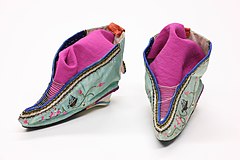Lotus shoe
[2] Women used scissors, needle and thread, bamboo embroidery frames, awls, and small irons to make their shoes.
[1] In addition, lotus shoes were often decorated with images that symbolize good luck, as well as culturally significant puns.
[4] The color red, a symbol of virtue, was reserved for special occasions such as weddings, anniversaries, and New Year celebrations.
[5] The designs and stylistic choices of lotus shoes varied depending on factors such as regional cultures, local traditions, and economic conditions.
[7] Footbinding had an olfactory and medicinal component; women would dust alum powder, an astringent, between their toes before wrapping their feet in handwoven cloth binders.
Women also used powdered herbal tonics with formulas passed down intergenerationally to soften their bones or speed up the healing process.
[7] Families that could afford to lose a daughter's capacity for strenuous physical labor began footbinding at a younger age.
This meant that the age at which footbinding commenced was inversely proportional to class, where upper-class girls’ physical labor was more expendable than it was to lower-class families.
[7] Rather, for women and girls in the relatively poor region of Shanxi province, footbinding served the dual purpose of pushing women into the sedentary work of spinning and weaving, while also showcasing a woman's domestic handiwork, making her a more attractive bride.
[2] Though foot binding is no longer practiced, many lotus shoes survive as artifacts in museums or private collections.

